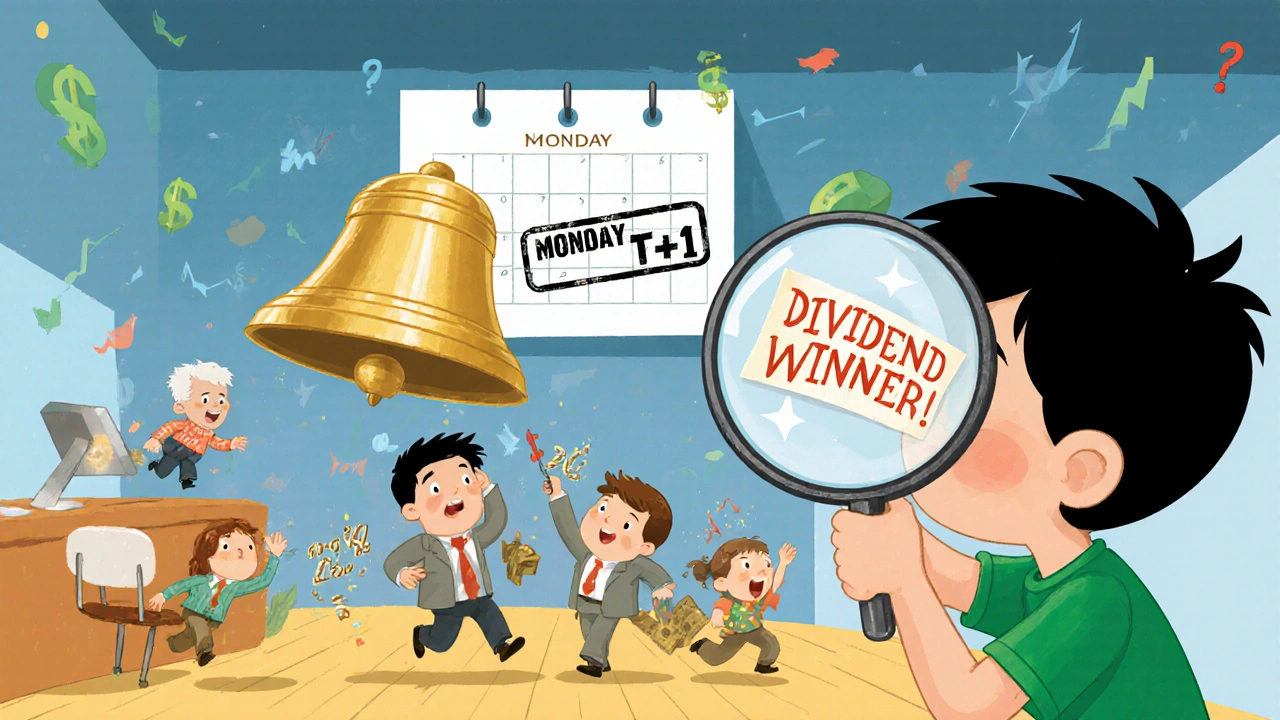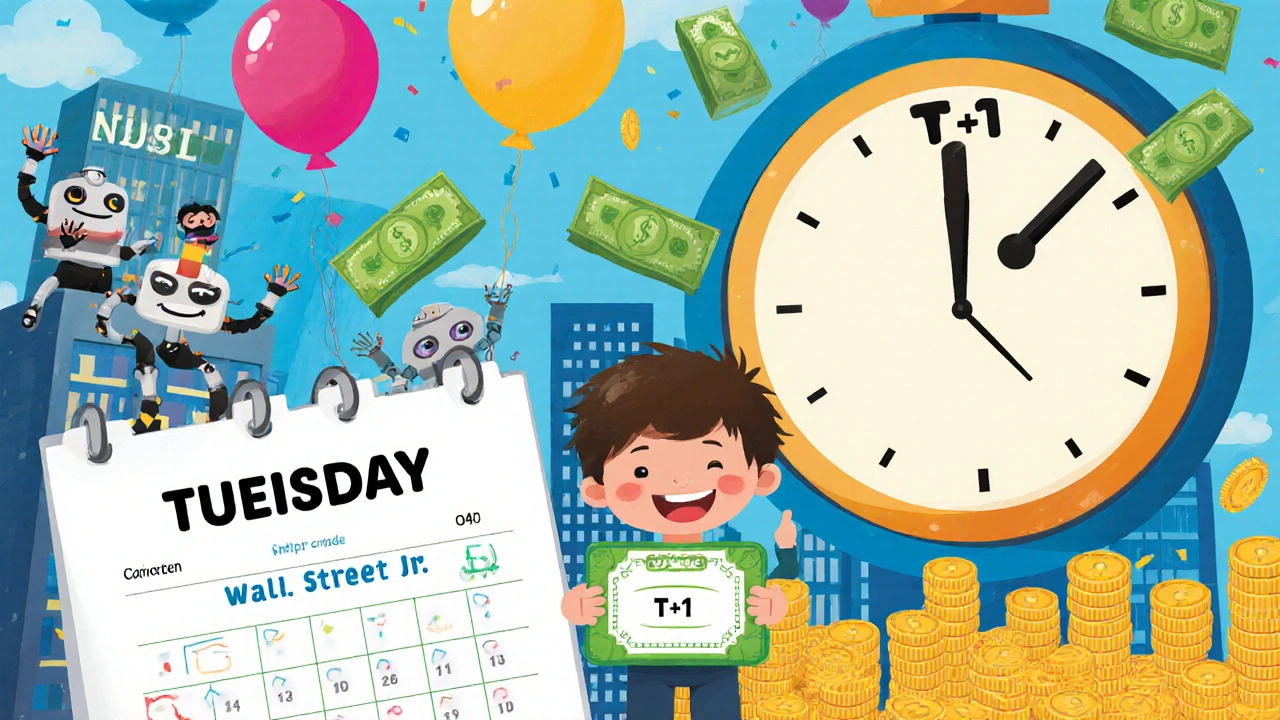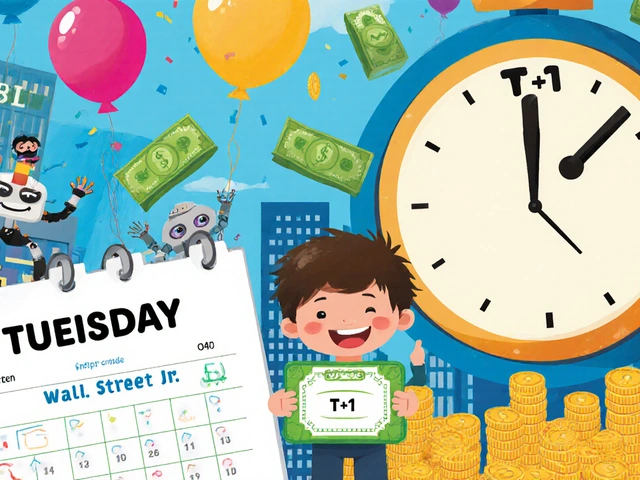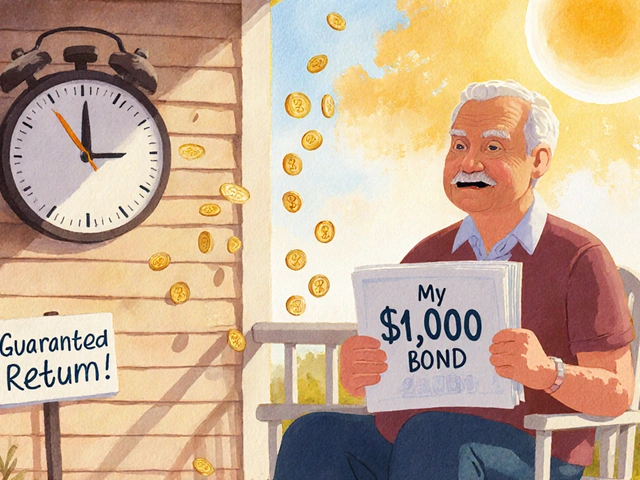T+1 Dividend Eligibility Checker
Check Your Dividend Eligibility
Enter your trade date and the stock's ex-dividend date to see if you'll qualify for the dividend under T+1 settlement rules.
How Dividend Eligibility Works
Under T+1: You must own the stock at the end of the trade date to qualify for dividends.
Under T+2: You must own the stock at the end of the settlement date (2 business days after trade).
Key Difference: With T+1, the ex-dividend date is the cutoff. If you buy on the ex-dividend date or after, you miss the dividend.
When you buy or sell a stock, the trade isn’t final the moment you click "buy" or "sell." There’s a behind-the-scenes process that happens after your order executes-and it’s changed dramatically since 2024. If you’ve noticed your cash shows up faster after selling a stock, or you missed a dividend because you bought a day too late, you’re feeling the impact of the shift from T+2 to T+1 settlement. This isn’t just a technical tweak. It’s a major upgrade to how the entire stock market operates-and it affects every investor, whether you trade daily or hold stocks for decades.
What Exactly Is a Trade Settlement?
Trade settlement is the process where money changes hands for shares, and shares change hands for money. It’s the final step that makes your trade real. Before settlement, you own the promise of a stock-not the actual stock. Your broker hasn’t yet received the shares from the seller, and the seller hasn’t yet received your payment.
The "T" stands for trade date-the day you placed the order. The number after the plus sign tells you how many business days later settlement happens. Under the old T+2 rule, a trade made on Monday settled on Wednesday. Under the new T+1 rule, that same Monday trade settles on Tuesday.
This might seem like a small shift. But in financial markets, one day matters. One day can mean the difference between catching a dividend, avoiding a margin call, or getting hit with a settlement failure.
Why Did the Settlement Cycle Change from T+2 to T+1?
The move to T+1 didn’t happen overnight. It was a decade in the making. Back in 2017, the industry switched from T+3 to T+2 to keep up with technology. But by 2021, something happened that exposed a weakness: meme stocks like GameStop exploded in volume. Retail investors bought billions of shares in days, overwhelming the old T+2 system. Settlement fails spiked. Brokers had to restrict trading. Margin calls ballooned.
The Securities and Exchange Commission (SEC) saw the problem. Longer settlement times meant more risk. If one party defaults between trade and settlement, the whole chain gets disrupted. With T+2, there were two full days for things to go wrong. With T+1, that window cuts in half.
In July 2023, the SEC officially mandated the switch to T+1, giving firms 15 months to update their systems. By May 28, 2024, every SEC-registered broker-dealer in the U.S. had to comply. Today, over 97% of U.S. stock trades settle in one business day.
How T+1 Changes Your Daily Investing
If you’re an active trader, T+1 is a game-changer. You can reinvest proceeds from a sale one day sooner. Sell a stock on Monday? You can use that cash to buy another stock on Tuesday. Under T+2, you’d have to wait until Wednesday.
That extra day adds up. Over a year, that’s 250+ extra trading days where your money can be working for you. J.P. Morgan estimates T+1 reduces margin requirements by 20-30% because brokers need less cash on reserve to cover unsettled trades. That means lower fees and more flexibility.
But it also means you need to be more precise. Dividend eligibility now depends on owning the stock at the end of the trade date, not two days later. If you buy a stock on Friday for its dividend, and the record date is Monday, you’ll miss it under T+1. Why? Because you won’t own the shares until Tuesday-the ex-dividend date has already passed. You need to buy by Thursday to get paid.

What Trades Are Affected by T+1?
T+1 applies to most common securities: stocks, ETFs, corporate bonds, and mutual funds bought through brokerages. But not everything changed.
- Government bonds were already on T+1 and stayed there.
- Stock options settled on T+1 before and still do.
- Municipal bonds and some international securities still settle on T+2 or longer due to complex paperwork or time zone delays.
- Cryptocurrencies aren’t covered by this rule-they operate on their own timelines.
That inconsistency can trip you up. If you’re trading both U.S. stocks and foreign ETFs, you might see some trades settle in one day and others in two. Always check your broker’s settlement details before placing an order.
What Happens If Settlement Fails?
Even with T+1, things can go wrong. A broker might not deliver shares. A bank might delay a payment. The Depository Trust & Clearing Corporation (DTCC), which handles the back-end processing for nearly all U.S. trades, reported that on the first day of T+1 (May 29, 2024), 99.87% of trades settled successfully. That sounds great-until you realize 1.2 million trades needed manual fixes.
Most of these were minor: mismatched account numbers, incorrect share quantities, or timing errors between international trades. But for the investor, it means your cash or shares might be delayed. Brokers are required to notify you if a settlement fails, but many don’t explain it clearly.
If you see a trade marked as "unsettled" longer than expected, don’t panic. Contact your broker. Ask: "Is this a normal delay, or is there a settlement issue?" Keep records of your trade confirmations. They’re your proof of what was agreed to.
How T+1 Impacts Small Investors vs. Big Firms
Big firms like Fidelity and Charles Schwab spent millions upgrading their systems. They had the resources to test, train, and automate. But smaller brokerages? Many had to spend $450,000 on average to comply, according to industry surveys. Some couldn’t afford it-and had to partner with larger firms just to keep operating.
For you as an investor, this doesn’t change much on the surface. But it does mean fewer small brokers exist today. Consolidation is happening. If you’re with a small firm, check if they’ve upgraded their settlement systems. Ask them directly: "Are you fully compliant with T+1?" If they can’t answer clearly, it’s a red flag.
On the flip side, T+1 benefits retail investors more than ever. Faster access to cash, fewer settlement failures, lower collateral costs-all of this makes the market safer and more efficient for the average person. A FINRA survey found that 81% of retail investors approved of T+1 once they understood how it worked.

What’s Next? T+0 and the Future of Settlement
The SEC has already said they’re looking at T+0-settlement on the same day as the trade. J.P. Morgan and other industry leaders believe it’s possible within 3-5 years, thanks to real-time payment networks and blockchain-backed systems.
But T+0 isn’t simple. It requires global alignment. If the U.S. settles trades in real time but Japan still takes two days, cross-border trades will still face delays. Payment systems in Europe, Asia, and Latin America aren’t synced. The Federal Reserve says resolving these disparities is the biggest hurdle.
For now, T+1 is the new normal. And it’s working. The industry saves an estimated $3.5 billion a year in reduced collateral and operational costs. Risk of default has dropped by half compared to T+2. And investors? They’re getting their money faster-with fewer surprises.
What You Need to Do Now
Don’t wait for your broker to explain T+1. Take control:
- Check your trade confirmations. Look for the settlement date. It should be one business day after the trade date.
- Adjust your dividend strategy. Buy dividend stocks at least one day before the ex-dividend date to qualify.
- Plan trades around holidays. If you sell on Friday before a holiday, settlement might not happen until Tuesday. That’s still T+1, but it feels slower.
- Don’t assume your cash is available. Just because you see the cash in your account doesn’t mean it’s settled. Wait for the official settlement date before using it for new trades.
- Ask questions. If you’re unsure about a trade, contact your broker. Get confirmation in writing.
T+1 isn’t just a rule change. It’s a step toward a faster, safer, more transparent market. The system is better. But only if you understand how to use it.
What does T+1 mean for my cash after selling a stock?
Under T+1, if you sell a stock on Monday, the cash from that sale will be available to use for new trades on Tuesday. Before May 2024, it would have been available on Wednesday. This gives you one extra day to reinvest your money.
Do I still need to wait two days to buy a stock after selling one?
No. With T+1, you can buy another stock the day after you sell. There’s no longer a three-day waiting period. But make sure the sale has settled before you use the cash. Some brokers show cash as "available" before it’s officially settled-don’t rely on that. Check your trade confirmation for the settlement date.
Why did I miss a dividend even though I bought the stock before the record date?
Under T+1, you must own the stock at the end of the trade date to qualify for dividends. The record date is set by the company, but eligibility is based on who owns the shares when the trade settles. If you bought the stock on the day before the ex-dividend date, you won’t own it until after the record date. Always check the ex-dividend date, not just the record date, and buy at least one day before that.
Are international stocks affected by T+1?
It depends. U.S.-listed international stocks (like ADRs) settle on T+1. But if you buy a stock directly on a foreign exchange-say, a Japanese company listed in Tokyo-it may still follow T+2 or longer. Your broker will usually handle the difference, but it can cause delays. Always confirm the settlement timeline for foreign securities before trading.
Is T+1 better for long-term investors?
Yes, but not in the way you might think. Long-term investors don’t trade often, so faster settlement doesn’t directly affect them. But T+1 reduces overall market risk, which benefits everyone. Fewer settlement failures mean a more stable market. It also means fewer broker restrictions during volatility. So while you won’t notice it daily, T+1 makes the entire system safer for your holdings.
Final Thoughts
The shift from T+2 to T+1 was one of the biggest changes to U.S. markets in decades. It wasn’t flashy. No headlines screamed about it. But it made the system stronger. Faster. More reliable.
For the average investor, it means less waiting, fewer surprises, and more control over your money. But it also demands more attention. You can’t just set it and forget it anymore. Know your settlement dates. Understand dividend rules. Double-check your trades.
Markets evolve. So should you. T+1 isn’t the end-it’s the new baseline. And the next step? T+0 is already on the horizon. The system keeps moving. You just have to keep up.




Just wanted to say thanks for laying this out so clearly. I’ve been confused about why my cash wasn’t showing up right after selling, and now it makes sense. I always assumed it was a broker delay, not a system-wide change. Took me three missed dividends to finally look into it. T+1 isn’t flashy, but it’s quietly better.
OMG YES. T+1 is the unsung hero of retail investing. No more playing ‘cash roulette’ with your buys. I’ve been swing trading since 2022 and this single change cut my settlement stress by 70%. Brokers still say ‘available balance’ like it’s the same as settled-NOPE. That’s the trap. Always check the settlement date. Also, dividend timing? Absolute minefield now. Learned that the hard way on NVDA last year 😅
This is an absolute masterclass in market infrastructure reform. The T+2 to T+1 transition wasn’t just operational-it was existential. The meme stock chaos of early 2021 exposed the fragility of a two-day settlement window. When Robinhood froze GME, it wasn’t about liquidity-it was about systemic risk. T+1 cuts the exposure window in half, reduces counterparty risk, and forces brokers to modernize. The $3.5B annual savings? That’s not just efficiency-it’s systemic resilience. And yet, most retail investors still treat settlement like a black box. We need better transparency, not just faster cycles.
It is truly fascinating how such a small technical adjustment-reducing settlement from two days to one-can ripple through the entire architecture of financial trust. In a world where time is the only non-renewable resource, this change gives back to the individual investor a sliver of agency. I recall reading about the ancient Indian concept of ‘Kala’-time as both destroyer and creator. Here, time is no longer a passive force but an engineered lever for fairness. Yet, I wonder: in our rush toward speed, are we losing the wisdom of patience? The market moves faster, but does the mind keep pace? For the long-term holder, this may seem trivial, but for the novice, it is a lesson in precision. I hope more educators take this as an opportunity to teach not just trading, but responsibility.
T+1 is good. Just check settlement date. 😊